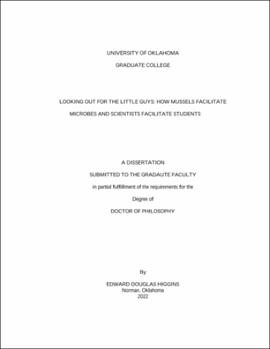| dc.description.abstract | Animals can have large impacts on how ecosystems function, from influencing population dynamics of other plant or animal species, to modifying hydrogeological flow dynamics. One ecosystem function that has received widespread attention is the biogeochemical transformation of key nutrients required for primary production. Freshwater mussels are benthic species that in dense communities, act as biogeochemical hotspots with landscape-level impacts. Mussels can cycle nutrients through their own metabolism, but the observed changes in ecosystem-scale nutrient transformations are also largely influenced by microbial metabolism. My dissertation examined the complex interactions between freshwater mussels and environmental microbial communities and how these interactions shape nutrient dynamics. Then, I investigated how scientists can effectively communicate their research in ways that promote participation in the broader scientific community.
Chapter one explored microbial communities associated with mussels in discrete, but proximate microhabitats in a southern US river. Mussel microbiomes (shell and biodeposits), were less diverse than those in surface and subsurface sediments. Mussel abundance was a significant predictor of sediment microbial community composition. Mussel species richness and distance between sample sites were not significant predictors of microbial community composition. These data suggest that mussels and local habitat conditions that change dynamically along streams, such as discharge, water turnover, and canopy cover, work in tandem to influence environmental microbial community assemblages at discreet rather than landscape scales. Further, mussel burrowing activity and mussel shells may provide interactions between microbial communities critical to nutrient cycling in these systems
Chapter two investigated how mussels can influence microbial community structure and function in the sediment under different nutrient regimes. I transplanted freshwater mussels and natural river sediment to flow-through mesocosms with different nutrient amendment treatments and monitored changes in microbial community composition over one week. I compared these microbial communities to activity measurements of ecoenzymes known to correlate to microbial function and nutrient availability. Mussels always changed sediment microbial community composition, but the final microbial community composition was also dependent on ambient nutrient concentrations. Further, mussels homogenized the stoichiometric ratios of ecoenzyme activities, indicating a consistent function of sediment microbes associated with freshwater mussels. My results suggest that mussels may promote functional redundancy in sediment microbial communities and highlight the importance of animals in controlling biogeochemical transformations under changing nutrient conditions.
Chapter three studied how STEM intervention programs can effectively improve the self-efficacy and self-concept of younger generations of scientists. I surveyed students who participated in a week-long, virtual workshop with a focus on computing in the biological sciences. The workshop had daily seminars and a career mixer to introduce students to scientists in academic, government, and commercial careers. Courses were most frequently taught by graduate students to implement a peer-to-peer mentoring strategy. The workshop was successful in improving student self-efficacy but had more modest success in improving student self-concept. Results were not different among demographic groups, indicating this STEM program did not mirror detrimental impacts on minority students seen systemically across STEM.
Taken together, this dissertation demonstrates that investigations into interactions between animal and microbial communities can improve our understanding of how ecosystems function. Further, it demonstrates that effective outreach and education of scientific knowledge is crucial to the continuity of science as a broader ecosystem. | en_US |

